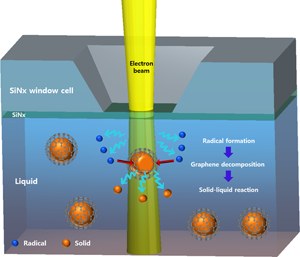Article contents
In Situ Observation of the Early Stages of Rapid Solid–Liquid Reaction in Closed Liquid Cell TEM Using Graphene Encapsulation
Published online by Cambridge University Press: 10 December 2021
Abstract

In situ liquid cell transmission electron microscopy (TEM) is a very useful tool for investigating dynamic solid–liquid reactions. However, there are challenges to observe the early stages of spontaneous solid–liquid reactions using a closed-type liquid cell system, the most popular and simple liquid cell system. We propose a graphene encapsulation method to overcome this limitation of closed-type liquid cell TEM. The solid and liquid are separated using graphene to suspend the reaction until the graphene layer is destroyed. Graphene can be decomposed by the high-energy electron beam used in TEM, allowing the reaction to proceed. Fast dissolution of graphene-capped copper nanoparticles in an FeCl3 solution was demonstrated via in situ liquid cell TEM at 300 kV using a cell with closed-type SiNx windows.
Keywords
- Type
- Materials Science Applications
- Information
- Copyright
- Copyright © The Author(s), 2021. Published by Cambridge University Press on behalf of the Microscopy Society of America
References
- 1
- Cited by





